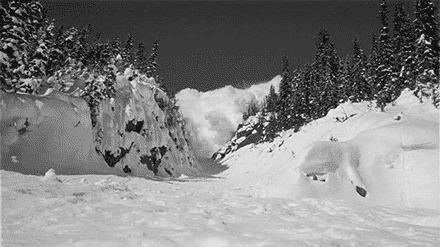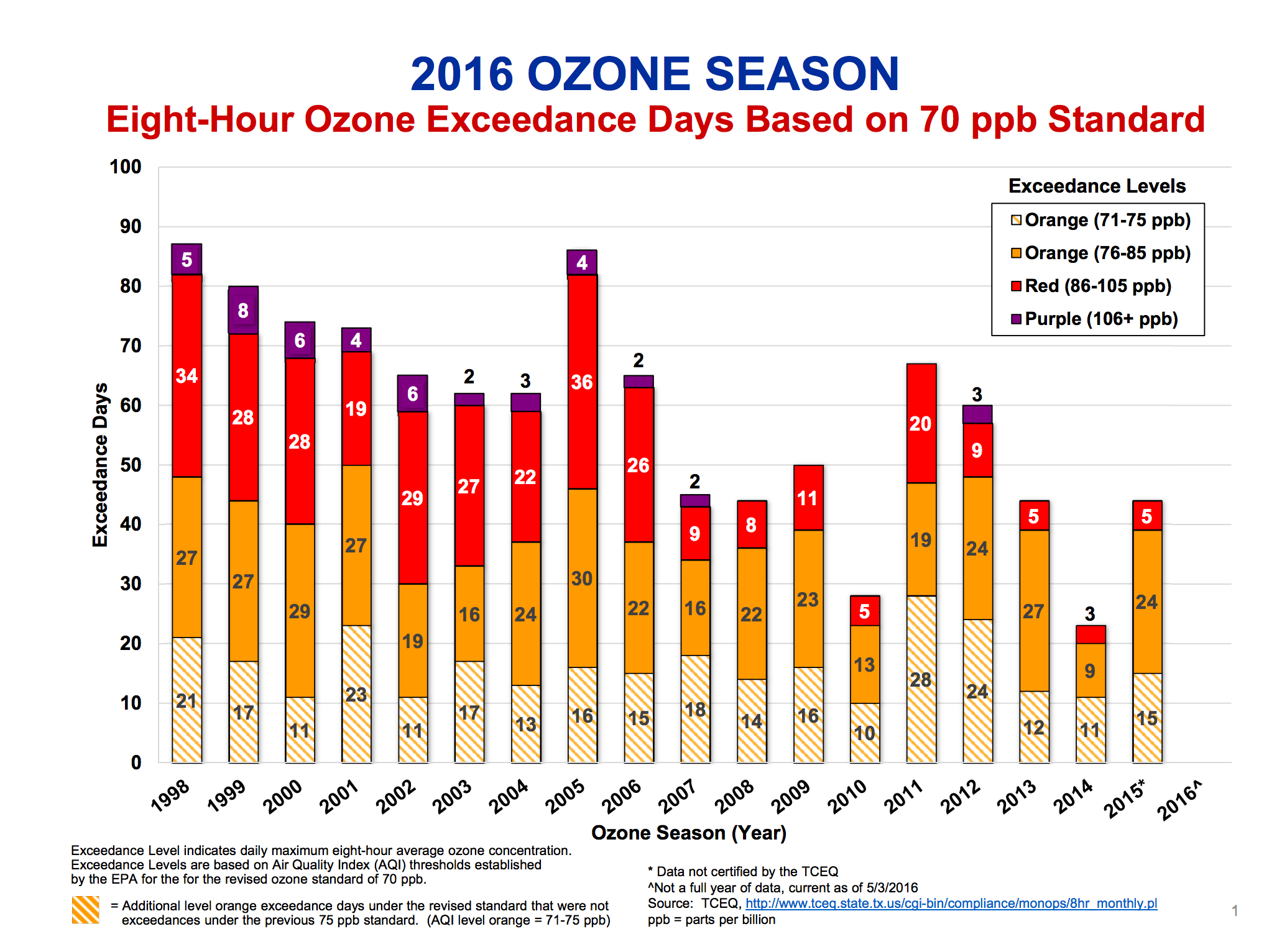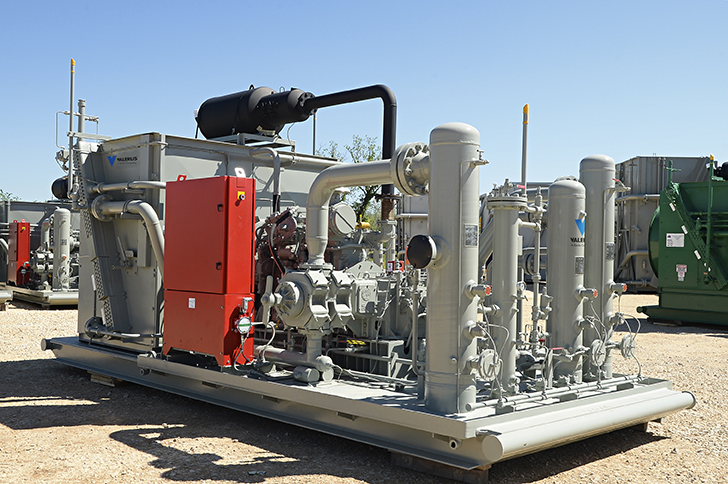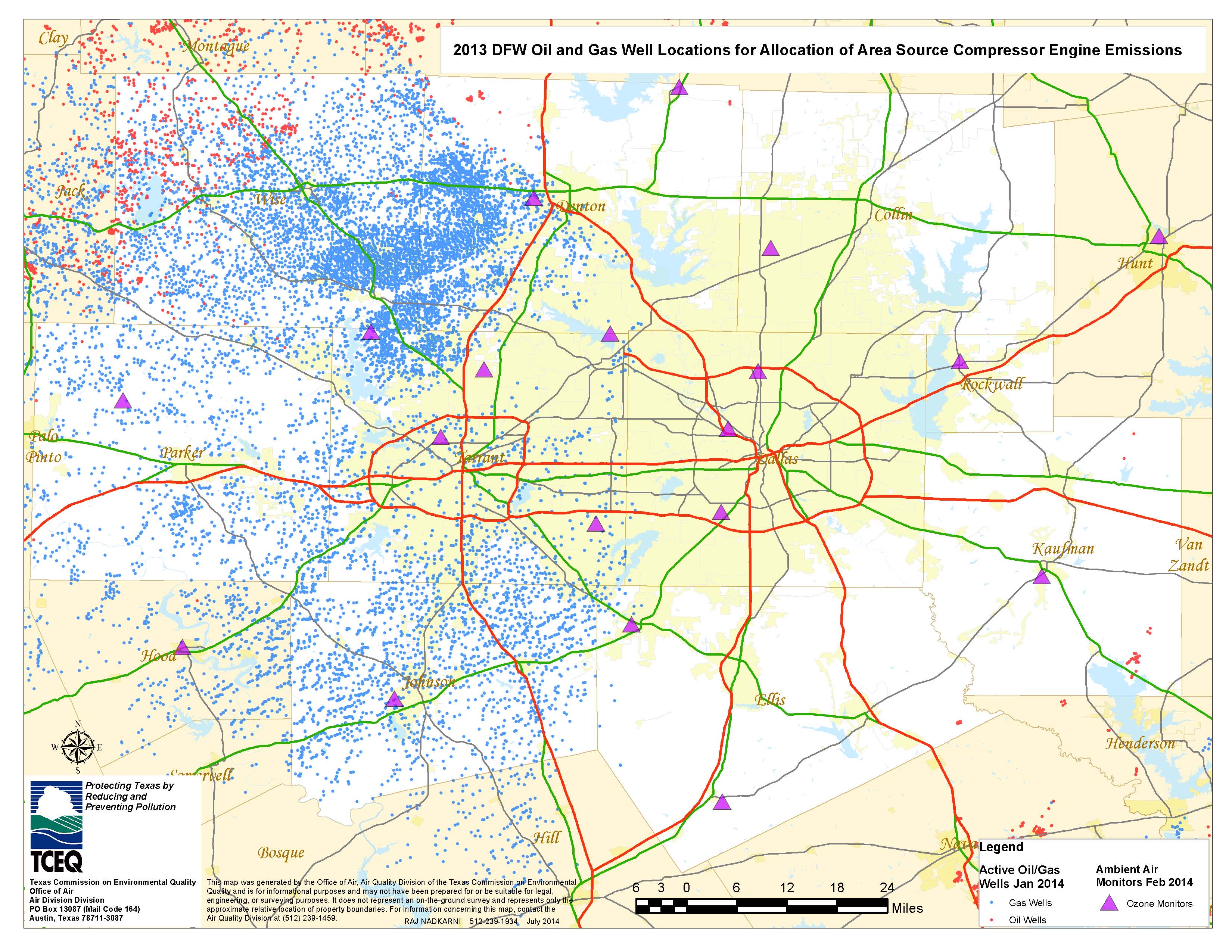Mansfield
Mysterious Catastrophic Air Pollution Episode is Why DFW Needs its Own Air Sensor Network
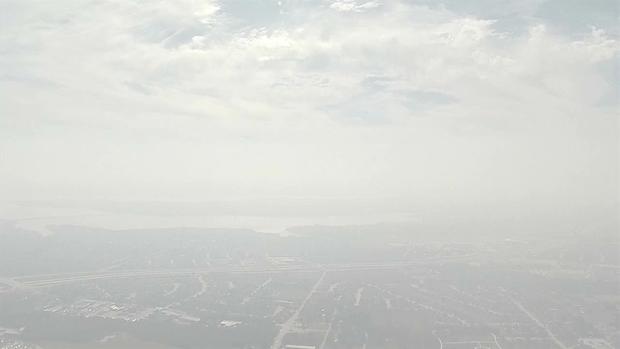
Not quite two weeks ago, on Thursday October 19th, something happened to throw local air quality conditions into the red zone for most of the day.
There was a inexplicable smokey haze extending along the limestone escarpment from Midlothian to Dallas and then north to Denton, sending Particulate Matter pollution soaring to Beijing levels and ozone readings so high the whole regional average went up a part per billion. Countless downwind residents complained to officials, FaceBooked, and Tweeted about “the smell of burning plastic” enveloping their neighborhoods with the smoke, which was so thick many thought the problem was just down the street.
 The 24-hour standard for Particulate Matter Pollution is 150 ug/m3. The annual standard is 12.
The 24-hour standard for Particulate Matter Pollution is 150 ug/m3. The annual standard is 12.

70 ppb is the new ozone standard.
The events took the Texas Commission on Environmental Quality completely by surprise. Commission computer forecasting had not predicted an Ozone Alert Day or warned of heavy PM pollution. Officials were playing catch-up for the rest of the day.
Now almost two weeks later nobody official knows what caused this Really Bad Air Day. Not the EPA. Not the Texas Commission on Environmental Quality. Not the DFW area citizens who breathed in the dirtiest air their lungs have seen all year.
Despite the sophisticated technology available to us in 2017, a single unexpected incident upwind of DFW can throw the entire North Texas air shed into the danger zone with no warning and no clue as to what initiated it.
Readings from state monitors were of no help until damage had already been done. As usual they were two hours or more behind in reporting. The numbers they were displaying at 12 noon were actually taken at 10 am. You had no idea what was going on in real time so that you might better protect yourself or family.
There are only three or four Particulate Matter pollution monitors in all of DFW. Even if you’d wanted to use the state’s current monitoring system to track this mystery plume, you couldn’t have done so. It doesn’t have that capability.
As inquiring reporters called, the TCEQ staff found a variety of things to blame. TCEQ suggested the smoke was from a Bastrop forest fire near Austin. But readings from monitors between Bastrop/Austin and Dallas show there was no problem south of Midlothian that day, while there was a huge problem north of there at the same time. Eyewitnesses who saw the plume on Thursday reported a thick narrow ribbon of a plume you’d see coming off a near-by source, not the sort of diffused cloud you’d expect to witness after traveling more than a hundred miles downwind. And then there’s that “burned-plastic smell.”
Then it was maybe one or more “controlled burns” in the Midlothian-Mansfield area. As it turns out, neither fire department found evidence of any permitted controlled burns in their own jurisdictions that could have cause so much pollution. Midlothian’s single permitted fire for the day was “the size of a coffee table” according to a department employee.
According to the Mansfield Fire Department “a fire” was reported to be located at Kimball Road and Hwy 287 just north of the Midlothian city limits. This is what’s at that intersection:

Please note the caution against open flames. Could a fracking site have produced the kind of particulate matter pollution and haze we saw on October 19th without methane or other kinds of pollution being released en masse as well? It doesn’t seem like it could. But what if the fracking site had been turned into a temporary waste incineration site for the day?
That’s not all. A satellite pic of the intersection and what’s around it reveals Kimball and Hwy 287 to be a kind of rogue’s gallery of potential suspects:
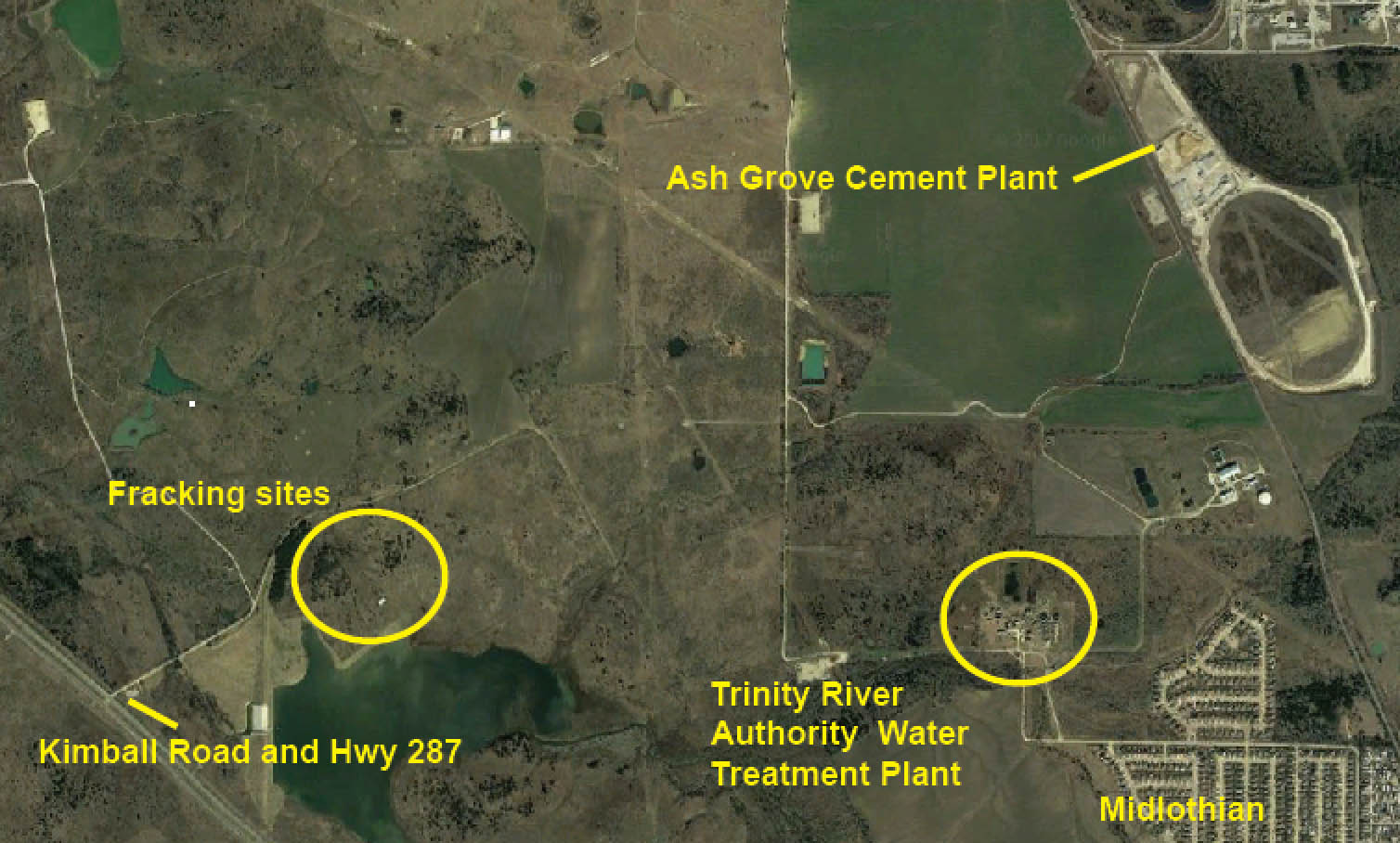
Besides the fracking sites you can be see in mid-drilling on this Google street level tour, the road leads to a Trinity River Authority Wastewater Treatment plant and the back door of the giant Ash Grove cement plant.
TRA is a shadowy, 60-year old regional bureaucracy that owns millions of acres of land, reservoirs, landfills, and wastewater-treatment facilities. It’s been in environmental hot water before. Wastewater treatment accumulates a lot of solids, and the TRA handles a lot of trash. It’s not inconceivable that it had something to do with the October 19th incident by thinking it could get away with an open burn on its own property.
Ditto for Ash Grove. Like the other two cement plants in Midlothian, Ash Grove’s kiln is allowed to burn industrial waste, including used oil, tires and plastics – remember the oft-cited “smell of burning plastic” citizens reported on the 19th? Waste-burning cement plants have had their wastes combust and cause huge fires before and each plant has its own emergency response crew which might be able to put out a fire without calling Midlothian.
There’s no proof Ash Grove, TRA or the fracking sites were the cause of the October 19th public health disaster. But there’s also no proof yet they didn’t cause the problem.
The truth is: there’s no official explanation for what made the air so dangerous to breathe on October 19th .
More truth: As of Friday, October 27th the TECQ had not even opened an official investigation into this matter – which again, sent Particulate Matter pollution to levels not seen outside SE Asia and single-handedly raised the regional ozone level.
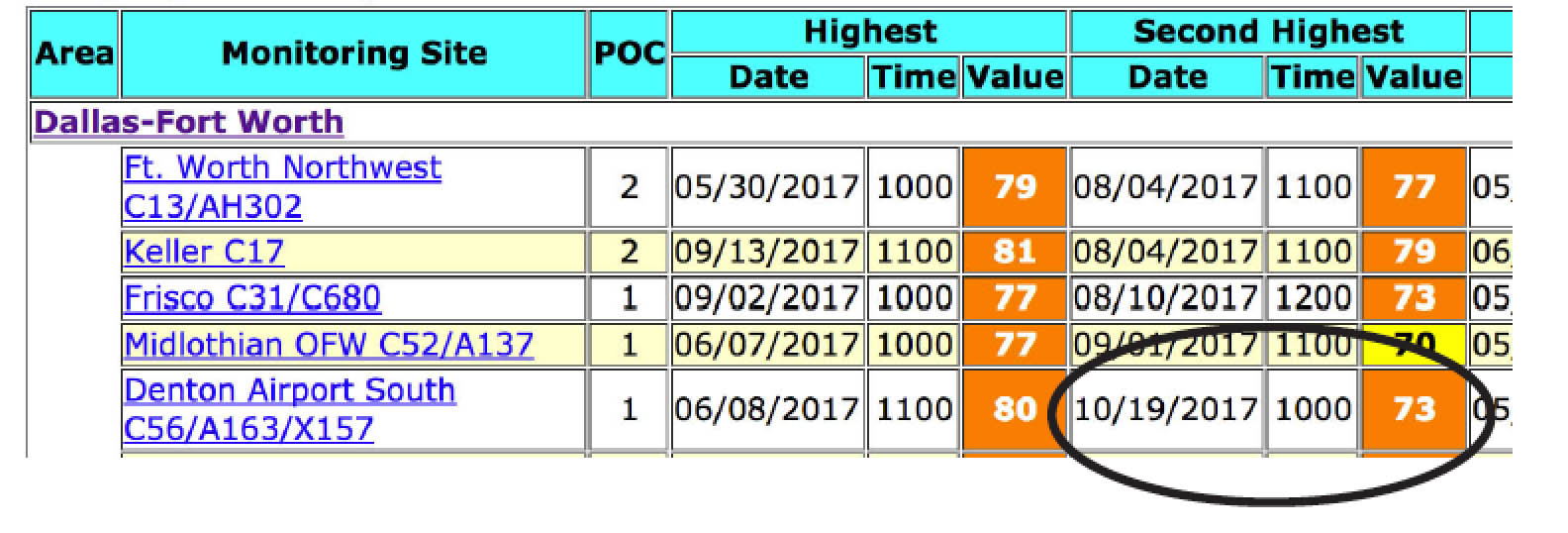
This is why Downwinders at Risk filed the first of what we’re sure will be a series of Texas Open Record Act requests last Friday seeking:
“Any and all printed or electronic documents and electronic media containing information concerning or related to ozone, particulate matter and/or haze air pollution readings and levels in the Dallas-Forth Worth non-attainment area on Thursday, October 19th 2017, including official ozone action warnings issued, complaints filed about air quality in the Dallas-Fort Worth area that day, photographs, satellite images, computer modeling, as well as all material related to any questions, inquiries, or investigations about air quality in DFW on October 19th anyone in the TCEQ, or contracted by TCEQ has been tasked to perform since October 19th or is still performing currently, and e-mails, letters, reports, telephone logs and notes, memos and all other material about October 19th air quality from 6 am Tuesday October 19th to Wednesday October 25th, 2017.”
TCEQ has until November 10th to respond. We’ll keep you posted.
In the meantime, this episode becomes Exhibit A in why DFW needs to catch-up with other metro areas and build its own network of high tech air quality sensors.
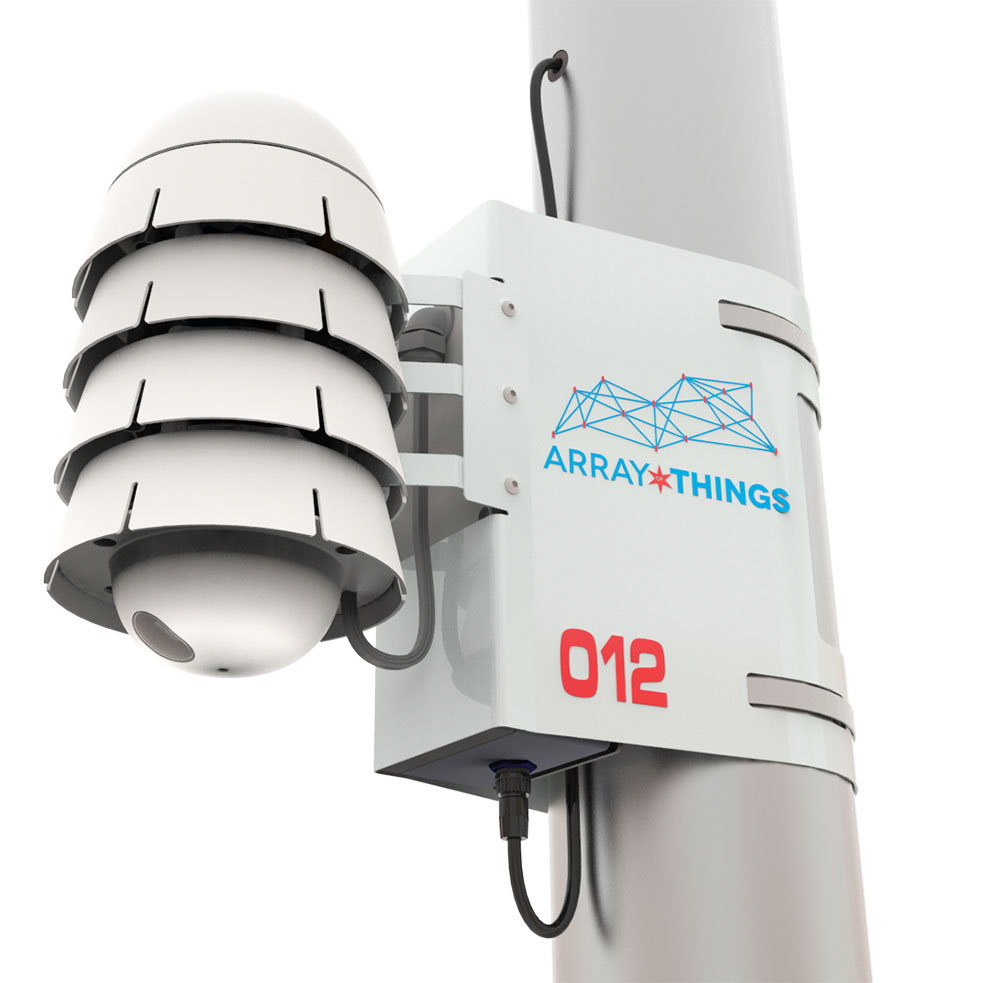
If such a grid had been in place, there would have been a real time warning of the PM and ozone pollution being generated shortly after the it started. There would have been a way to locate the source of the pollution right away and do something about it before it got worse, and there would have been a way to predict the plume’s course and warn those in its path before it got there – not two hours after it arrived.
In this sense a modern sensor grid is actually a pollution prevention device, an investigative tool, and an early warning system all rolled into one.
In a metropolitan area that’s been out of compliance with the Clean air Act for 27 years and counting over 14 million lungs are being held hostage by a state air quality monitoring system left over from the 1990’s. It’s being maintained by a state agency that’s run by polluters, officially thinks smog isn’t bad for you, and is cutting its air monitoring budget.
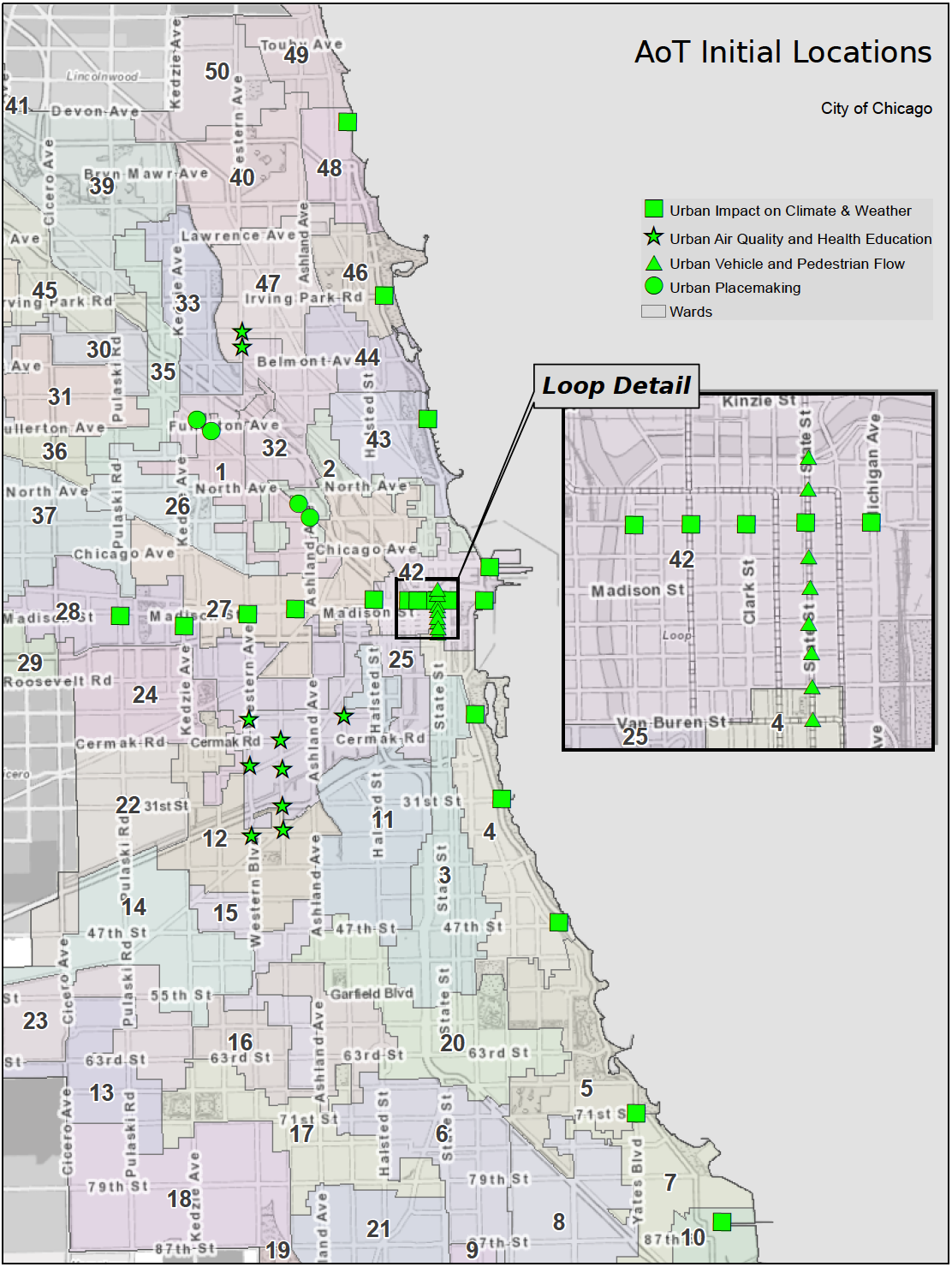 There’s no desire in Austin to update this obsolete system and no money to do so. If DFW officials want to utilize 21st Century technology to help them clean their air, they’re going to have to build their own network of air monitors – exactly the proposal the DFW Air Research Consortium was trying to get funded with a National Science Foundation grant. Close, but no cigar.
There’s no desire in Austin to update this obsolete system and no money to do so. If DFW officials want to utilize 21st Century technology to help them clean their air, they’re going to have to build their own network of air monitors – exactly the proposal the DFW Air Research Consortium was trying to get funded with a National Science Foundation grant. Close, but no cigar.
Without the NSF grant, local officials are going to need to get creative. Are there private businesses who might want to sponsor an app that could tell give you useful air quality info in exchange for naming rights: “Brought to you by the Nissan Leaf DFW Clean Air Network.” Are there local foundations that would contribute? What about local high-tech billionaire Mark Cuban? For less than a million bucks, DFW could have 500 Particulate Matter sensors that would be capable of of pinpointing a problem down to the street address.
Baltimore, Chicago, Chattanooga, Louisville, L.A. , Oakland, and Lafayette, Louisiana are all way ahead of DFW in building out their own local dense grid of air sensors. They’ve done it with a combination of private, government and academic know-how and financing.
We have as much, or more technical expertise and money than any of those locales and we should have more incentive given our chronic air pollution problem. There’s no reason we can’t build our own modern, more protective, more useful way of monitoring air pollution – even if the state isn’t interested. Not only can we do it, but in light of the events of October 19th, it should be considered a necessary act of public health self-defense.
Testify! Stop Getting Railroaded by the RRC
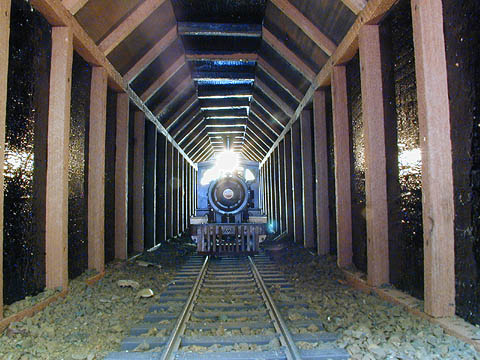 There's no better symbol of the anachronism that is Texas state government than the ineptly named Railroad Commission, or RRC. It has nothing to do with choo-choos, and everything to do with the State's oil and gas legacy.
There's no better symbol of the anachronism that is Texas state government than the ineptly named Railroad Commission, or RRC. It has nothing to do with choo-choos, and everything to do with the State's oil and gas legacy.
Or is it misnamed? Its innocuous title keeps it off a lot of citizens' radar screens while going about its business of shoving anyone or anything not in the oil and gas business around to make it more comfortable. Our drilling contaminating your water? You can to get the bottled stuff delivered. Our waste disposal causing earthquakes? You'll get used to it. Our air pollution causing your child's nosebleed? What's a couple of ER visits compared to our nation's energy security? Railroad? Yes – it's right there in our name.
Instead of being appointed by the Governor, the three RRC commissioners are elected statewide…with the help of contributions from the oil and gas industry. This isn't the fox guarding the hen house. There are no hens left.
This is why any review of the Commission, even one by the equally inept State Legislature, is a chance to get the word out about how god-awful the RRC is and what needs to be done to overhaul it. Beginning this month, that's what's happening, because 2017 is the year the Railroad Commission is getting "sunsetted" by the state.
Sunset laws demand that every state agency must come before the legislature and justify itself anew about every 12 years. Usually pro forma exercises, occasionally a terrible agency is allowed to die. Most have their missions amended or rules tweaked, or their names changed. this is how the "Texas Natural Resources Conservation Commission," or, "TNRCC/"TRAINWRECK," became the "Texas Commission on Environmental Quality/"TCEK." After being postponed last session, it's the Railroad Commission's turn now.
Tomorrow night's faux-official Town Hall meeting on the Railroad Commission being sponsored by Earthworks, Public Citizen and the Sierra Club is a kind of milk run for the more important job of testifying in front of state legislators in Austin later in the month, on the 22nd. Attend to find out how you can use this process to gain more publicity for its terrible record, and perhaps be able to actaully tweak the system to be more citizen-friendly.
Texas Railroad Commission Town Hall
Tuesday, August 2
Grapevine Convention Center
1209 Main St.
(located off 114 and Main St. exit)
Registration: 6:30 pm
Program: 7:00 pm
Texas Railroad Commission Public Testimony at the Capitol
Monday, August 22
For more information on the whole process, talk to Rita Beving with Public Citizen and the Sierra Club, 214.557.2271
Why a small variance could mean a big increase in DFW smog
Thousands of gas wells, pipelines, storage tanks, compressors, and other pieces of infrastructure in oil and gas patches, which individually don't emit the huge volumes of air pollution coming from a single cement kiln or a coal plant can, when combined, easily total tonnage larger than both.
And that's what has happened in DFW over the last decade. As the Barnett Shale boom crept further into the region's "non-attainment" area" for smog, all the air pollution from all those thousands of individual sources begin adding up and having an impact on air quality.
While other large sources were actually decreasing their pollution, the oil and gas sector was going the opposite direction. It ballooned. To the point where it's now the fourth largest category of air pollution in that "non-attainment area." The three sources that outrank it? 1. All vehicles on the road. 2. All vehicles off-the-road, and, 3."area sources" a catch-all term including everything from backyard BBQs to small paint shops, and probably some oil and gas sources itself. Oil and Gas air pollution is, by volume, now the largest source of industrial air pollution in the North Texas area, exceeding the Midlothian cement kilns, local power plants (now all gas-fired), and large manufacturing plants like the GM truck and SUV factory in Arlington. Only the East Texas coal plants emit more and their 90-100 miles outside the nonattainment boundary (another problem that needs fixing).
At the same time oil and gas air pollution rose from Barnett Shale development, DFW smog levels, which had been declining, began to plateau. For a decade now the annual smog average has hovered on either side of 85 parts per billion (ppb) – the obsolete 1997 standard that we were supposed to reach in the early Oughts. We were at 86 ppb of smog in 2008 and we're now at 83 ppb.
Look at the chart below, generated by the North Texas Council of Governments. In 2007 DFW had 45 "exceedence days". In 2015, DFW had 44 "exceedence days." There's a very good case to be made that oil and gas air pollution has prevented DFW from making the kind of air quality progress it might have otherwise made without that burden.
For the last five years, the State of Texas has been on a mission to deny any link at all between the oil and gas industry in the Barnett Shale and DFW smog. It's gone out of its way to hide the real volumes of pollution emitted by these sources, as well as avoiding or downplaying the significance to regional air quality of decreases in that pollution. That's not hyperbole, it's the record.
In looking ahead with its proposed DFW air plan now in the pipeline, the State has predicted that a drop in the number of new wells in the Shale will equal a drop in the amount of air pollution coming from O&G sources. Sounds logical doesn't it? Yet the industry's own text books say that it ain't necessarily so.
A drop in new wells is the tip of the O&G iceberg in DFW. Just because there were no new wells drilled last month doesn't mean there's no new pollution being released this month. Some 20,000 wells, almost 1000 large compressors, untold thousands of smaller compressors, millions of gallons of storage capacity, miles of pipelines – these all continue to operate and emit huge amounts of air pollution 24/7.
And when production-per-well drops, and the densest parts of the patch begin to play out, as is occurring now in the Barnett, investors don't usually go with the flow. They want to increase the flow. And so they install more "lift compressors" to squeeze every last molecule of gas they can out of a well. These compressors, powered by gas or diesel, increase air pollution. Not by a lot by themselves, but when you start putting them together, by the thousands, then yeah, they have an impact. And so, even when O&G production is declining, you can have increases in O&G air pollution.
Downwinders at Risk and the Sierra Club made this argument in our comments about the state's plan, providing sources from industry to show exactly how this has taken place plenty of times before. We told Austin it was underestimating the impact of O&G air pollution – again. The State dismissed our concerns and said no problem.
Which brings us to Mansfield in Tarrant County, scene of the last pre-HB40 gas ordinance fight in the state.
Last week, there was a small headline in the Fort Worth Star-Telegram a lot of people probably ignored. It concerned a routine variance to zoning code being requested by (notorious) gas well operator EagleRidge. At issue was whether the company could keep using gas powered lift compressors instead of electric-powered ones as the city's year-old ordinance required. EagleRidge made an argument in favor of the variance which sounded very familiar to some of us….
EagleRidge first noticed a dramatic decline in natural gas production at 15 of its wells last year, as it went from 8 million to 2.5 million cubic feet of natural gas per day. Low natural gas prices, trading about $2.10 per British thermal unit Monday, could make the wells economically unfeasible, according to Mark Grawe, executive vice president of EagleRidge.
That prompted EagleRidge to try a new strategy, using small gas lift compressors that increase production on the wells. Last year, Mansfield granted a six-month variance to allow the compressors on a trial basis.
Grawe said the compressors have already improved production on three of the wells, but addition tests are needed on EagleRidge’s other wells.
Eagle Ridge got its variance. And besides the three lift compressors it's operating on the site now, at least two to three more or expected, and all of those might one day be replaced by two giant-sized compressors. And, Eagle Ridge told the council, it's experience in Mansfield will be repeated at "hundreds of wells in Southeast Tarrant County" that have also seen declining production.
Eagle Ridge's ratio was approximately one lift compressor for every two wells. There are 15 wells as part of this one variance, "hundreds" in SE. Tarrant County waiting their turn, and 20,000 more throughout the part of the Barnett Shale in the DFW non-attainment area for smog. That's thousands and thousands more lift compressors emitting lots more air pollution even as Barnett Shale production is declining – and most will be located in cities or counties where there's not even a requirement for electric power to get a variance from. In other words, this is exactly the scenario Downwinders and the Sierra Club warned about in their comments, but which the state dismissed.
That's in addtion to the thousands of lift compressors already located in DFW, the exact number and location of which are unknown to EPA and Texas because they don't require indivdual permits. Austin "estimates" the total amount by using, you guessed it, production numbers. Here'a map from the Texas Commission on Environmental Quality guestimating where all those existing lift compressors are now:
If you think there might be a correlation between O&G pollution and stagnating DFW smog levels, what's the answer? It's pretty straight-forward. Stricter emission standards for all equipment, leak detection, electrification of large and small compressors. These are all things the industry is either doing in fits and starts in North Texas and elsewhere, or being required by the new EPA methane rules, but they're not being applied across the board in the Barnett Shale, or they don't apply to existing facilities, or both.
Who's going to make that happen? Local governments were doing some of it – up until the passage of HB40. For example, Dallas, Mansfield, and other cities required electric-powered compressors and state-of-the-art leak detection. But that's off the table, as is any action from Austin. That leaves the EPA as the one regulatory entity that could, if it wanted, impose uniform emission standards on all O&G facilities in the 10-county non-attainment area, including Denton, Johnson, Parker, Tarrant, and Wise counties. It could do so as part of it's own anti-smog plan for the region.
But before it can start writing its own plan, the EPA must first reject the state's. And for it to do that we must give the EPA the political support it needs to stand up to the backlash from Austin you know will come. Thus the need for resolutions from DFW cities and counties asking the EPA to reject the State plan. Thus the need to show-up this coming Monday morning at City Hall and support an effort by Dallas City Councilwoman Sandy Greyson to have the City of Dallas join Dallas County in calling for EPA intervention in DFW air quality: 9am Room 6ES, Quality of Life Committee.
Don't let the Mansfield variance become the regional template.
The Last Frack Fight?
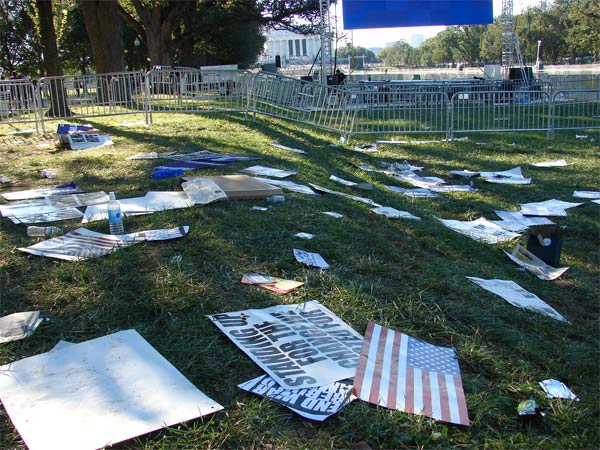
In Austin, the HB 40 hearing started late and continued far into the night. In Mansfield, the third reading of the new ordinance with the old setbacks was following the script. Between the apocalyptic tweets emanating from the one and the dismal Kabuki theater playing out in the other, it was hard to tell. Was this the beginning of the end, or the end of the beginning?
If the Texas legislature has its way, the long hard two-year slog from outraged neighborhood to fourth (or was it the fifth?) revision of the city's gas drilling ordinance that concluded at the Mansfield City Hall Monday night might be the last Old School Home Rule fracking fight the Barnett Shale sees for some time. But unlike, Southlake, or DISH, or Dallas, this one didn't end with unqualified victory for the residents.
Timing is everything, and the Mansfield fight was peaking at exactly the wrong time with the wrong group of timid elected officials. Before Denton, and the Banshee legislative session of 2015, it might have been possible to get longer setbacks. But now, it was out of the question. The City Council was unanimous in its reluctance to piss off Austin any further by extending a buffer zone past 600 feet, or pass something for the hell of it that would be repealed in a matter of months anyway. There was way more discussion and debate over a proposed assisted-living facility than the proximity of another 300 gas wells to 50,000 people.
For almost two months, the industry had been pushing back hard, with telephone campaigns, Astroturf websites, and industry reps parachuting into nearly every Chamber of Commerce and business association meeting. Trade associations pumped money into the fight like their collective lives depended on it. And maybe they did. Mansfield is in Tarrant County, the Belly of the Barnett Shale Beast, and in territory it thought it had bought and paid for years ago. The very idea!
Which makes what Mansfield Gas Well Awareness did over the last year that much more remarkable. It clawed its way into the city council's agenda after being blown off with promises they'd be "no fracking on Sundays." It kept the issue in front of City Hall's face until the council agreed to revise the ordinance again. It did that with a handful of people, lots of determination, and no money. In Ed Ireland's backyard, they took on the gas industry and kept getting further down the field.
And so while Monday was a disappointment compared to the goals of the original campaign, in many respects, it was also a draw. Despite all the money spent by industry, supporters of a stronger ordinance with longer setbacks turned out in equal number to the line-up of realtors and royalties owners who liked things just the way they are.
Mansfield kept is archaic 600 foot setback, a relic from 2008. On the other hand, for the first time anyone could recall, there was a provision added that requires the notification to potential homebuyers within 300 feet that they're moving into close proximity to a gas well. That's important. An educated homebuyer is the movement's best friend. Other cities should expand on this concept of notification – especially since it may be one of the only ways left soon to influence the industry at the local level. Call it the Right-to-Know Who Your Industrial Neighbors Are.
And while the city council voted against them, one of the rank and file of Mansfield Gas Well Awareness is now running for council. Tamera Bounds declared her candidacy in late February. She's taking on long, long, long time incumbent Cory Hoffman. A victory by Bounds would send a strong message to City Hall that the reactive form of regulation it now favors isn't proactive enough.
One of the most interesting things about Monday night was the rhetoric deployed by either side. Because Mansfield has over 200 wells already, there was no shortage of anecdotal information about wells gone wrong or what living next door to one was really like. Many of the supporters of longer setbacks talked about their own first-hand experience. The ones who didn't do that spoke with first hand knowledge of reading specific studies and the survey of peer-reviewed, journal-published scientific literature now available. It was all very fact-based. Here's what I saw/smelled/breathed. Here's what I read.
What was funny was that the canned speeches from industry accused them of using scare tactics (Science! Experience!) and importing ideas from Russia (seemingly unaware that the former Soviet Union is now in vying with Texas for world headquarters of crony capitalism). Presentations by the proponents of the status quo talked about how sacred property rights are in Texas and America, how everything is awesome with the city, and how everything would be terribly un-awesome if there wasn't gas drilling. But they never cited one study, never mentioned a statistic, or related how research was proving them right about the safety of proximity to wells. Any objective literary comparison would find all the scare tactics and exaggerated rhetoric unmoored to any scientific facts coming from the side that was accusing their opponents of using this very approach. Ironic, huh?
You'll also be glad to know that, according to Mr. Ireland, the gas industry produces "no air pollution," so those numbers (97 tons per DAY of Volatile Organic Compounds and Nitrogen Oxides) in the last state air plan that placed gas facilities as the single largest non-mobile source of smog-causing pollution in DFW were just, you know, numbers – as opposed to his more authoritative assertions). Lucky for Ireland the industry still has so much money to spread around to sell its case. If it's ever left up to his intellect alone, it's in big trouble.
At the conclusion, you kept asking yourself if that's all they had? Boiler plate "you're a socialist" dribble combined with climate change-like denial of the scientific research. It's all flag and dollar waving. But in March of 2015, in Mansfield, Tarrant County, Texas, it was enough to deny another 900 feet of protection to residents.
Back in Austin, Energy Resources Chairman Drew Darby's own bill drew 100 plus speakers, many from Denton and other cities that had already had their fights. The Texas Municipal League said over 300 Texas cities wouldn't be able to enforce their own gas drilling regulations if HB 40 became law. No new ordinances would be allowed.
In the past, you wouldn't expect such an extreme piece of legislation to pass, except it's 2015, the two-thirds rule, and Wendy Davis, are gone in the Senate, even some "liberal" Democrats are being enticed by industry money, there are no such things as moderate Republicans anymore, and oh, yeah, Denton. Has there been another single college town since Berkeley that set off more over-the-top reactionary alarms?
And so it's possible that the final unsatisfying unanimous vote in Mansfield on Monday night could be the conclusion to Texas' last local fracking fight. Beginning of the end, or end of the beginning?
Mansfield Misdirection: Med Waste Hype vs. Gas Industry Reality
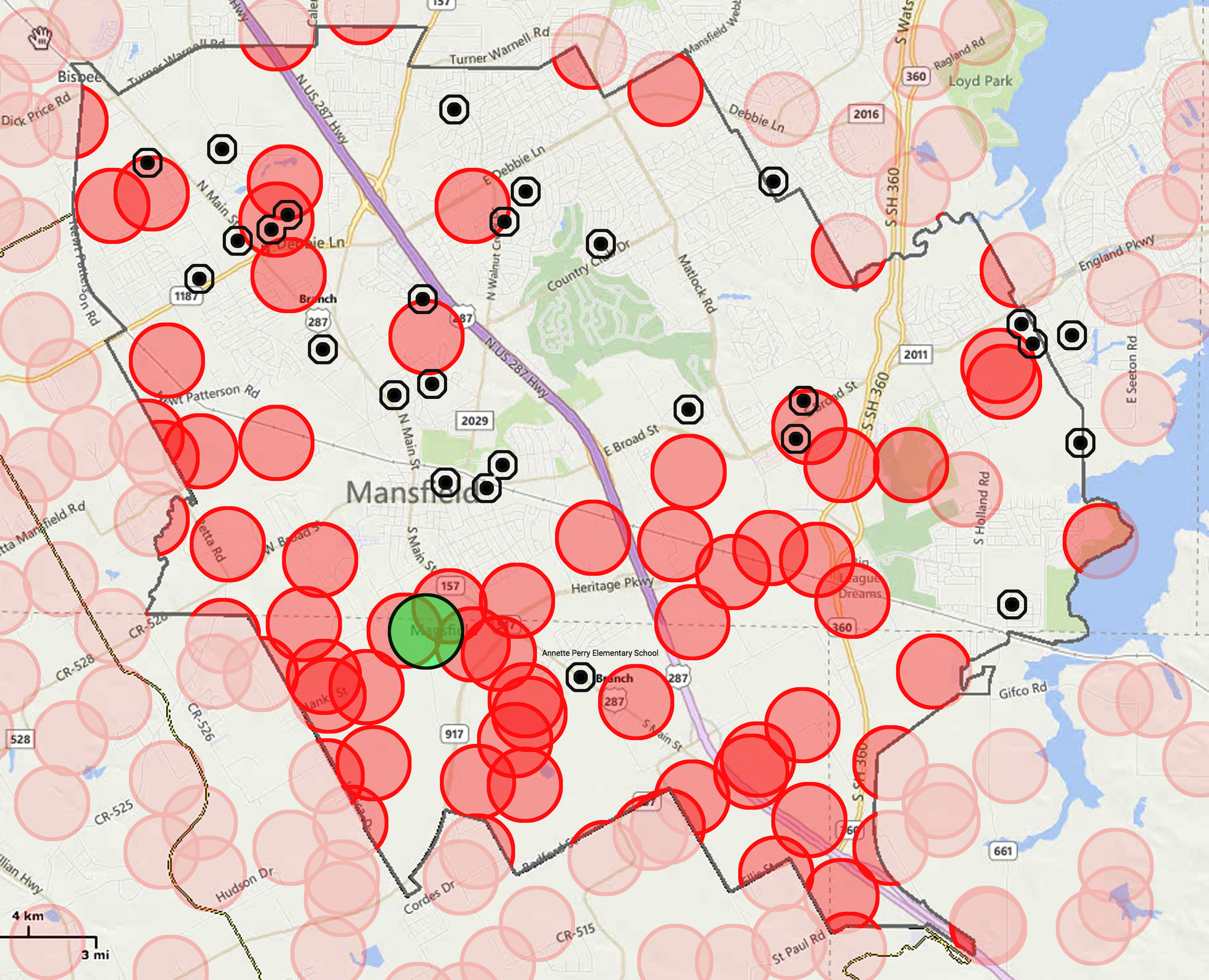
The green dot is a 1500-foot radius around a medical waste transfer station. The red dots are 1500-foot radiuses around gas wells. The black dots are schools. Guess which dot the City Council and School Board are outraged about?
2nd Reading of Proposed Gas Drilling Ordinance
Mansfield City Council Meeting
Monday Night, March 16th 6:30 pm
City Hall, 1200 E. Broad Street
In the art of slight-of-hand, there's a classic maneuver called misdirection. It's when the trickster forces the attention of an audience to focus on one thing in order to distract its attention from another.
In 2015, the largest, most egregious act of political misdirection in North Texas is taking place in Mansfield. With its 60,000 residents surrounded on all sides by 200 plus gas wells, emitting tons of toxic air pollution in the middle of residential neighborhoods, and next to schools and parks, official outrage is focused on the siting of a single medical waste transfer station that will release…no toxic pollution at all.
Oh, the Redaway transfer station application has lots of salacious wording. It will take in tons of "animal waste, bulk blood, bulk human blood, bulk human body fluids, microbiological waste, pathological waste, sharps, and other health care-related items that come into contact with body fluids and/or blood) and non-hazardous pharmaceuticals." Nasty stuff. But it will take this waste, put it in one of three large steam autoclaves, sterilize it, and ship it out to be buried at municipal solid waste landfills elsewhere. All inside an enclosed structure. This isn't a disposal facility. This isn't an incinerator. It's a place where medical waste comes in, gets Martinized, and then gets shipped back out.
But wait, there's tons of storage and up to 50 trucks a day of come and go traffic. What if this is near a neighborhood or upwind of schools? You'd want this kind of facility far away from people. Like in an area zoned for industrial uses. Which it happens to be located in. The nearest school is over a mile away, the nearest residential neighborhood almost as far.
Yet even this distance is way too close for comfort for the City Council and School Board. They don't even want the transfer station in the city limits. For these officials, there's no setback far enough to be safe from the dangers of escaped body parts. They're outraged. They've passed resolutions condemning the facility. They've even protested to the Texas Commission on Environmental Quality!
What exactly is the public health threat posed by the transfer station? It's not air pollution. The steam autoclaves emit so little pollution they aren't even required to have a permit. Nor is it water pollution. Everything drains into the city sewer system. It's the perceived threat of icky stuff like body parts and animal wastes and the accidental contamination from HIV-infected needles that fall off the trucks. In an industrial park. A mile away or more from the nearest school or neighborhood. Behind a fence, inside a building.
Meanwhile there are 206 gas wells strewn throughout the city, emitting half a ton, a ton, or maybe more air pollution a year depending on the age, design and activity. Carcinogens, Mutagens, Endocrine Disrupters. Many of these wells are within 1500 feet of neighborhoods and schools. Some are within 600 feet – the current setback required by the city. Some schools and neighborhoods are within 600 hundred feet of multiple wells. These wells routinely release toxic pollution. These wells pose a threat of accidental release or explosion or fire.
Taking a conservative estimate of half a ton of pollution a year, these 206 current wells could be releasing over 100 tons of air pollution a year. But 300 more are planned too. That's another 150 tons of air pollution. And that's not even counting the compressors, dehydrators, tanks etc. that go along with having that many wells in your town. 250 tons of air pollution is a lot.
So let's review. According to the Mansfield City Council and the Mansfield School Board, even though there are no emissions, and no disposal activity, and it's located in an industrial park, there's absolutely no appropriate distance between the medical waste transfer station and any neighborhood or school in the city. 600 feet, 1500 feet, 5280 feet – it doesn't matter. There is no such thing as a safe buffer zone from this facility. Zero tolerance.
On the other hand, 600 feet is more than a safe distance for proximity of neighborhoods and schools to heavy industrial activity that drills deep holes in the ground, pumps thousands of gallons of toxic chemicals into those holes under pressure, forces underground explosions and then tries to contain and process the resulting releases of gas and liquid coming back up through those holes. 600 feet is OK for constant exposure to toxic chemicals at "low levels." 600 feet is an appropriate distance in case of serious accident, because you're only dealing with highly flammable and explosive substances, not gross human blood.
Now, the more cynical among us would claim that this official misdirection is due to the fact that the city, school system, and property owners aren't getting a percentage of the tipping fees for the tons of waste passing through the transfer station the same way they're getting royalties from those hundreds of gas wells. Take the money out of the gas wells and they might not be allowed so close to people. Let the medical waste station cut property owners in on the action, and it too might be welcomed as a jobs creator.
But by any objective test of current and potential threat, gas wells trump the medical waste facility. Just one gas well pumps more pollution into the atmosphere in a year than the transfer station will in a decade.
On Monday night the Mansfield City Council will have its "second reading" for its proposed updating of the town's gas drilling ordinance. Concerned residents will continue to push for longer setbacks from homes and schools than the existing 600-feet the new ordinance reaffirms. They aren't asking to kick gas wells out of the city, the way the city is with the transfer station. They're just asking for the same level of protection afforded other North Texas towns like Dallas, Southlake and Flower Mound.
Setbacks are crucial because they're one of the few proactive measures that can be taken to avoid harm from a gas well or compressor, rather than reacting to it after the fact.
Longer setbacks prevent as many people from being exposed to as as much pollution, both routine and as a result of accidents, leaks and "blowdowns." The more distance there is between people and heavy industry, the fewer risks to public health. Fewer respiratory problems. Fewer nose bleeds. Fewer cancers. Fewer birth defects. Longer setbacks are a reasonable response to the science in 2015.
But the city and school board are holding fast. Zero tolerance for body parts. 600 feet for toxic pollution. That's why it's important for concerned residents to show up on Monday and call BS on this hypocrisy.
During the month long Ebola panic in the U.S., not one citizen died of the disease that dominated the headlines. However, if statistical evidence from the CDC is to be believed, probably close to 600 people died from the flu during those same four weeks. Which was the greater public heath threat?
There is something truly frightening in the medical waste application. It's the breakdown of land use within Mansfield. As it turns out, the city is "28.6% residential , 3.7% commercial, 3.7% industrial and warehouse, 4.9% parks, 4.3% public/semi public, and 13.3% gas wells and rights-of-way." Gas drilling now takes up more land use in Mansfield than all the commercial, industrial and park property combined. With 300 more wells to go, the city is looking more and more like a large industrial park with pockets of residential development instead of the other way around.
But don't worry about that. Be concerned about the building in the corner of the industrial park steam-cleaning blood, needles and body parts.
Worried Much? Gas Industry Desperate to Hold Back Truth and Mansfield Ordinance Reform
 For almost a year, Mansfield residents have been trying to rewrite their city's drilling ordinance to better reflect the science surrounding the public health consequences of heavy industry taking place so close to people. During this entire time, and countless appearances before their city council, there has not been one Mansfield citizen who came forward and defended the current approach.
For almost a year, Mansfield residents have been trying to rewrite their city's drilling ordinance to better reflect the science surrounding the public health consequences of heavy industry taking place so close to people. During this entire time, and countless appearances before their city council, there has not been one Mansfield citizen who came forward and defended the current approach.
But now that the Mansfield council is ready to act on a new ordinance, the gas industry is doing exactly what it's always accusing their opponents of doing, sending outsiders in to invade the town and spread misleading information. And they're doing it in a big, desperate way. Let's just review what's happened in the last couple of weeks:
Industry hired a sleazy push polling firm to conduct a Mansfield campaign by phone that purposely misleads about the impact of the revisions to the ordinance being sought and makes personal attacks on the residents pursuing those revisions.
Sent in trade association speakers from Austin and Fort Worth to Mansfield to further mislead the business community about the revisions being sought.
Set up an e-mail site where industry employees, no matter where they live, send their comments to the Mansfield City Council, in opposition to any revisions.
And last night, (Sunday) the industry released a "study" purporting to show how safe the existing 600 foot setback was in Mansfield.
And these are just the things we know about right now. Having seen the huge multi-well Edge Resources permit get temporarily, but unexpectedly, tabled in January, the industry wasn't about to take any chances on seeing that happening again in their own back yard. So they've thrown everything and the kitchen sink into the Mansfield fight.
Of course, this reaction is a tremendous complement to the efforts of the intrepid Mansfield Gas Well Awareness group, that has, oh who knows, maybe a millionth of the budget the industry has already spent on these efforts. That the gas industry should be so frightened by calls for "responsible drilling" and more protective measures that have numerous precedents in the region tells you all you need to know about their insecurity post-Denton. It's almost comical.
Let's just take the latest effort that the Energy in Depth guys are generously calling a "study." Forget that if an environmental group were offering up such a thing, they'd be the first to point out its obvious bias. But of course, that objection disappears entirely when they fund the results. All of a sudden its a paragon of virtuous objective science. And mind you, these results were funded by the very gas operator who's well emissions are being sampled. No conflict of interest there.
Forget also that they're so proud of this work that they released it on a Sunday, after hours, the day before the Mansfield City Council takes up consideration of a new gas drilling ordinance. It's almost like they wanted to minimize the scrutiny of the thing.
Also put aside that this thing is not peer-reviewed or journal published – because the "science" is so poorly done that it could never pass review and get published in anything but an Energy In Depth blog post.
Also discount the love industry has for for testing levels of contaminants in the air versus its utter contempt for testing people and health. If you're going to claim as your working hypothesis that certain levels of contamination are completely harmless, and that anything that falls below certain levels is benign, then why not put that hypothesis to the test by performing an epidemiological study? But no, you see no such studies coming from industry, because they don't want to test that hypothesis.
One type of study is top, down. It looks at the levels of poisons in the air, and assumes that if they don't exceed the levels deemed dangerous by the regulatory arm of the industry , the Texas Commission on Environmental Quality, then everything must be hunky dory.
The other is bottom-up. It looks at the health of people who live adjacent to the facility releasing the poisons and determines whether their health is worse than those who don't live in close proximity to polluters, whether they are receiving officially sanctioned levels of poisons are not.
The reason the second type of study is a truer snapshot of reality is because we keep finding out that levels of poisons we thought were safe turn out not to be safe at all. Go back even 20 years to the Exide lead smelter in Frisco, or 30 years to the RSR lead smelter in Dallas. Regulators and industry were routinely saying that levels of lead being released by these facilities were "safe." As it turns out, they were not. In fact, science now says there's no level of exposure to lead that cannot do harm to a person, particularly a child.
This learning curve can be applied to many, many types of chemical exposures over the last few decades, including Benzene, and other poisons routinely released by the gas industry. And it's why industry never wants to test its hypothesis about "safe" levels of things in the air with studies of what the actual health of people who live near their facilities is really like.
In reality, the best epidemiological studies to date, those that ARE done by third parties and ARE peer-reviewed an journal published, all conclude that living near gas mining operations increases the likelihood that you'll get sick. That's the state of the science. It's the same kind of science that proved cigarette smoking causes cancer. And that's why industry wants to stick to telling you about how safe the levels of poisons are in the air.
But forget all of that. Let's just take this "study" thing at face value. There was a 100 minutes of sampling of the air in 2012 at a gas pad site before drilling started, and in 2014, there were three 30 minute samplings of air around 600 feet away from the pad site after drilling had begun, and one sampling site well away from the pad to function as a background reading. That's it. That's the entirety of the study: the comparison of this "before" and "after" short term sampling.
Now if you were a high school chemistry nerd looking for a shot in the local science fair, you might insist that the procedures and testing protocol be the same for the before and after sampling. And you'd be right. But this study didn't bother.
In 2012, the sampling looked at Volatile Organic Compounds (VOCs), Sulfur Compounds and Formaldehyde "and other Carbonyl Compounds." In 2014, the sampling only looked at VOCs. so, only one-third of the original 2012 testing was duplicated. You'd think they were trying to intentionally ignore some poisons or something.
But it gets better. There were 15 separate VOCs sampled for in 2012, but only six, (less than half and only barely more than a third), of those were sampled for in 2014. In other words, the 2014 sampling not only left out two-thirds of the 2012 contaminant categories, it left out most of the chemicals in the one category it did sample.
In 2012, you had a total of 100 minutes of sampling of air in the middle of the pad site. In 2014, you had three 30-minute samplings of air 600 feet away from the pad site. They couldn't even replicate the sampling time.
As Texas Sharon has already pointed out, you might want to do your sampling with the same general kinds of weather – circumstances that might promise a representative sample. But no, not for this "study." There was only a trace of rain recorded at the site in 2012, but between half an inch of rain and two and a half inches of rain in the 2014 sampling. Of course, rain being in the air and all, that could affect your air sampling results.
The average wind speed was 6 to 11 mph in 2012, while in 2014, it was, well, the second report really doesn't say what the average wind speed was. It just says that the wind speed varied from 0 to 21 along with wind direction. But who needs details for real science right?
In 2014, none of the background samples were the highest levels of exposure found, that is, the highest readings of all chemicals found were downwind of the pad site.
Of the six VOCs sampled for in both 2012, and 2014, three were significantly higher in 2014.
Benzene was almost 4 times higher in 2014: .13 vs .49.
Toluene was almost three times higher in 2014: .35 vs .91.
Methyl Ethyl Ketones increased by a third: from .53 to .72.
And mind you this was in the rain with gusts up to 21 mph. Only m,p Xylene and Carbon Disulfide were lower in 2014.
In all, these chemicals were detected despite the crappy methodology used:
- Benzene
- Benzene, 1,2,4‐trimethyl‐
- Benzene, 1,3,5‐trimethyl‐
- Benzene, 1,3‐dichloro‐
- Benzene, 1,4‐dichloro‐
- Carbon disulfide
- Carbon Tetrachloride
- Cyclohexane
- Ethane, 1,1,2,2‐tetrachloro‐
- Ethane, 1,1,2‐trichloro‐1,2,2‐trifluoro‐ (Freon 113)
- Ethylbenzene
- Furan, tetrahydro‐
- Heptane
- Methyl Butyl Ketone (MBK)
- Methyl Ethyl Ketone (MEK)
- Methyl Isobutyl Ketone (MIBK)
- Methyl Methacrylate
- Methylene Chloride
- Naphthalene
- o‐Xylene
- m,p‐Xylene
- Styrene
- Tetrachloroethylene
- Toluene
- Trichloroethylene
- Trichloromonofluoromethane (Freon 11)
That's reassuring right? That's what the industry folks are saying, because guess what, they're all at levels below what TCEQ says are OK for you to breathe – for a total of 30 minutes per sample. Unfortunately, most of us have a hard time breaking our habit of breathing all the time. Everyday. For years on end.
Look, you don't need to be a scientist to know how full of holes this slap dash attempt at CYA actually is. Industry is just throwing one thing after another up on the wall and hoping it sticks for the time it takes for the Mansfield City Council to justify its rejection of the citizens' revisions. Especially the 1500 setback originally requested.
Industry keeps saying that this distance amounts to a "defacto" ban of drilling, but that's clearly not the case in Mansfield. It's own literature touts the fact that a rig can be more than a mile away from the gas deposit its mining. You can put a rig in an industrial zoning tract and still reach a pocket of gas underneath a neighborhood without the surface components being anywhere near each other.
So what's the real reason industry oppose these setbacks for heavy industry that would be more than appropriate for any other kind of heavy industry? It's because the gas industry doesn't want to be grouped with lead smelters, and cement plants, and refineries and other kinds of heavy industry. It operates under an industrial exceptionalism that's unique in the modern era. It wants to be viewed as the kindly, well-landscaped heavy industrial polluter. Because when you start seeing it differently, all the carefully-constructed mythology surrounding its operations becomes transparent – just like it did with lead smelters, cement plants and refineries.
Because of its massive infusions of cash and resources overwhelming Mansfield in the last couple of weeks, the industry may indeed forestall the inevitable a little longer in what it considers a jurisdiction that's bought and paid for several times over. But science marches on – the real sort – and it's not going to be very kind to this industry in the longer run. Even the Marlboro Man had to hang up his spurs. It's just a matter of time before this industry is viewed as just another nasty polluting cause of illness, even by those who've benefited from it the most.
Push Polling in Mansfield Gas Fight Highlights Biggest PR Industry Offensive Since Denton
 (Mansfield) — Residents in this Fort Worth suburb seeking a more modern approach to gas industry regulation seemed to have hit a raw Barnett Shale nerve.
(Mansfield) — Residents in this Fort Worth suburb seeking a more modern approach to gas industry regulation seemed to have hit a raw Barnett Shale nerve.
A decision last month by the city council to postpone permitting of a giant new multi-well and compressor facility in Mansfield, pending development of a new gas ordinance, has spurred the largest and most expensive industry PR offensive since the fight over the Denton fracking ban vote last November, including a city wide “push polling” campaign that contain ad hominem attacks on local advocates.
“I guess we should be flattered that our efforts have attracted so much attention from the national gas organizations,” said Tamera Bounds, one of the targets of the industry’s efforts. “But the fact is, this is a matter for Mansfield residents, and over the course of the last nine months as we’ve been working with the city council on drafting a new drilling ordinance, to our knowledge not one Mansfield resident has addressed the council in favor of the old ordinance. Now, at the last minute, these national trade groups show up and pretend their speaking on behalf of our local interests. They aren’t.”
Although Bounds group began meeting in June 2014, and a city wide forum on a new gas ordinance was held in December, it’s the unanimous January 26th tabling of Edge Resources’ huge, 34 well, compressor, dehydrator, and storage tank complex by the Mansfield city council on its third and final reading that apparently has the industry worried they’re losing their influence in a town so deep in the Barnett Shale.
On the eve of the first reading of the newly drafted ordinance this coming Monday, Mansfield residents are getting calls from a number registered to The Woodlands-based Promark firm asking them to take part in its “survey” on Mansfield drilling issues. Promark is a notoriously partisan company with a pockmarked reputation. In 2004, Promark’s polling tactics were investigated by the American Association of Public Opinion Research for unethical polling practices. According to the AAPOR, push polls are “an insidious form of negative campaigning, disguised as a political poll. 'Push polls' are not surveys at all, but rather unethical political telemarketing — telephone calls disguised as research that aim to persuade large numbers of voters and affect election outcomes, rather than measure opinions.”
That certainly describes the line of attacks that were posed as questions asked during the company’s Mansfield calls, including “If the ordinances are passed, did you know that the City taxes could be raised? Knowing this, would you support a new ordinance?” and “If ordinances are passed, did you know that schools would loose a lot of funding? Did you know that property taxes will go up?”
Despite these scare tactics disguised as a “survey,” no part of the ordinance would affect current facilities. It’s aimed only at new permits. Residents have requested better monitoring and enforcement as well as a more protective 1500-foot setback from homes, schools and other “protected uses” to replace the 600-foot setback requirement established in 2008.
Perhaps most disturbing are the personal nature of some of the push polling questions. For example it asks whether respondents “agree that the clean air activists are a nuisance to the city?” and then whether Mansfield Gas Well Awareness Group leader Bounds is “credible, somewhat credible, or not credible”
Besides Promark’s push polling, which no trade group has yet claimed responsibility for, industry representatives are also suddenly showing up in Mansfield trying to drum up supporters among the local business community.
This Friday, Austin-based Luke Legate of the “Joint Association of Oil and Gas Education Initiative” is speaking to the Mansfield Business Association. The Initiative is a state wide industry trade group alliance that includes the Texas Oil & Gas Association, Texas Royalty Council, Texas Independent Producers and Royalty Owners Association, Panhandle Producers and Royalty Owners Association, Texas Alliance of Energy Producers, Foundation for Energy Education, Texas Pipeline Association, Permian Basin Petroleum Association, and the South Texas Energy & Economic Roundtable. He’s never appeared before the Mansfield City Council.
Next Thursday, it’s Ed Ireland, Director of the Barnett Shale Energy Education Council speaking to the entire Mansfield Chamber of Commerce at the Walnut Creek Country Club. The BSEEC describes itself as “founded by consortium of leading Barnett Shale production companies.” He was invited to the December forum that kicked-off the review of the new ordinance, but has not appeared at any of the regularly scheduled council meetings where gas was a topic since then.
“What’s ironic is that these are the very groups that rush to claim that “outsiders” are somehow responsible for stirring up local residents concerns, when it’s actually the industry’s own poor track record on the ground that’s promoting our activism,” said Erik Orsak, another Mansfield citizen leader of Mansfield Gas Well Awareness. “After months of good-faith negotiations between the city and concerned residents, we see this last-minute massive top-down wave of attacks by national trade groups invading Mansfield without any previous local support in an a attempt to try and undermine that process. It’s these industry groups that are the outsiders.”
Monday’s city council meeting will feature the “first reading” of a proposed ordinance and include a public hearing on its contents. While Mansfield Gas Well Awareness members say they’ve been pleased with the progress on some issues of concern to them, two of the most important, reducing harmful emissions and longer setbacks, have not been resolved to their satisfaction. Last month, they reminded the city council that Mansfield officials originally called for 1000 foot setbacks in 2008, but those got reduced after intense industry lobbying.
In fact it was the owners of Edge Resources, the same company some residents think is behind this wave of new industry lobbying after their permit was temporarily tabled in January, that wrote in an April 2008 letter to the Mansfield Planning and Zoning Commission and suggested that schools should have shorter setbacks “because children are very mobile.”
“It would be a shame if Mansfield were to make the same mistake twice based on industry bullying” said Lance Irwin, a Mansfield Gas Well Awareness member and a frequent critic of the industry’s operation in town. “Mansfield’s future is its children, its schools and its neighborhoods. We need to protect them as best we can.”
Monday’s city council meeting begins at 6:30 pm at Mansfield City Hall, 1200 East Broad Street
Both Gas Industry Spinmeister and Mansfield Compressor Spew During Thursday’s EPA Hearing
 There was at least one truth uttered by Steve Everley, the professional PR spokesperson for Energy in Depth, itself the PR arm of the Gas Industry, during his testimony at last Thursday's EPA ozone standard hearing in Arlington:
There was at least one truth uttered by Steve Everley, the professional PR spokesperson for Energy in Depth, itself the PR arm of the Gas Industry, during his testimony at last Thursday's EPA ozone standard hearing in Arlington:
"…natural gas producers will be significantly impacted by EPA’s proposal to reduce the National Ambient Air Quality Standard for ozone from 75 parts per billion to between 65 and 70 ppb."
Indeed. At the rate things are going in Austin and DC, it might be the only thing to impact the industry's large emissions of pollution for many years to come. Left unsaid by Everley was why the industry would be impacted by such a lower ozone standard – because in many parts of the country now, including the DFW area, smog-forming pollution from the gas industry is contributing significantly to higher ozone levels.
Even the governmental affairs branch of the gas industry, otherwise known as the Texas Commission on Environmental Quality, admits that facilities like compressors, storage tanks, pipelines, and de-hydrators found by the thousands in the western part of the Metromess contribute more smog-forming Volatile Organic Compounds (VOCs) than all the "on-road" vehicles in North Texas combined. This is true not only at the present time, but will be true at least three years into the future, according to TCEQ's own estimates.
Gas facilities also account for the third largest source of smog-forming Nitrogen Oxide pollution in DFW, according to TCEQ numbers included in their recent air plan submitted to EPA – only a ton per day less than all "non-road" vehicles in North Texas like construction equipment, and well ahead of "point sources" like the Midlothian cement kilns and local power plants.
In all, TCEQ predicts that 35,335 tons per year of smog-forming pollution will still be coming from the region's gas industry in 2018. That's a lot. It's so much that, as the TCEQ also demonstrates with its computer modeling, even a tweak here and there in gas pollution estimates can make big differences in the levels of ozone at monitors in places like Denton and Keller and Eagle Mountain Lake – traditionally the worst-performing air quality monitors in North Texas.
And that's why a lower ozone standard is a threat to the industry. The very air quality monitors the industry affects most with its pollution are the ones driving the region's high smog levels. Lowering the ozone standard means it would have to spend money to reduce those emissions significantly. It means it would have to spend money to prevent the kind of huge "accidental" releases of smog-forming pollution released by the Mansfield compressor on Thursday even while Steve Everley was testifying to EPA.
After giving her own testimony to EPA on Thursday morning, Earthworks' Sharon Wilson and Mansfield Gas Well Awareness board member Lance Irwin headed out to the Summit Midstream Partners Compressor Station behind Mansfield's Performing Arts Center, with an infrared, or FLIR "thermal imaging" camera. Such a device is capable of recording the kinds of VOC emissions that are often smelled and inhaled by surrounding residents, but can't be seen with the naked eye.
The Summit compressor and the two nearby Eagleridge gas wells have been the scene of many different complaints from the surrounding Mansfield neighborhood – everything from airborne foam landing in backyards to oily deposits landing on car finishes. On Thursday, Wilson and Irwin were responding to a new series of complaints about awful smells. When they showed up, what the two recorded was a massive "emergency blowdown" (versus the "planned" kind). While filming the event, Wilson suffered health effects familiar to gas facility neighbors and was overwhelmed by the obvious hydrocarbon fumes. Once you see her video, you understand why:
Such a blowdown was exactly what Lance Irwin had warned the Mansfield City Council about only three days before, during comments directed at slowing down or denying the permit for a new compressor, 34 wells, 12 tanks and a assortment of other facilities at an Edge pad site near Debbie Lane in town. He pointed out that industry and government estimates about emissions never take these kind of catastrophic events into account – form a short-term toxic exposure perspective, or as it turns out, from an air quality, smog-creating perspective. And he's right.
In this regard, these kinds of accidents are no different than the infamous industrial "burps" from refineries and chemical plants along the Houston Ship Channel that lead to smog spikes downwind. There are 650 large compressor stations in the DFW "non-attainment" area. How many are experiencing blowdowns on any given day? How many are affecting ozone levels in the spring and summer? The TCEQ estimates included in its DFW air plan don't even try to quanify them.
Because gas facilities like compressors are subject only to "standard permits," are located diffusely around a region, and don't officially emit a de minimus amount of air pollution, they're not subject to the federal rule of off-setting. That's when a new polluting facility locates in an already smoggy area like DFW and has to pay to cut smog pollution elsewhere if it wants to emit the stuff itself. If a new cement plant or power plant were to locate in DFW, it would have to pay to reduce a ton and a half of smog-forming pollution for every ton it wanted to release. Gas facilities don't have to do this – even though collectively they emit more smog-forming pollution than all the cement plants and power plant in the non-attainment area!
EPA has tried to argue that a company's different facilities are all tied together and should be counted as a single source, and so subject to off-setting regulations. But the courts have ruled against them.
Rising gas industry pollution and the absence of any official brake on its growth like off-setting is a large reason, maybe the primary reason, why DFW hasn't seen the kind of air quality progress it should have by now. Until this last summer's cooler and wetter weather gave us relief, ozone levels had been stagnating or even rising since 2009 – or about the time the industry invaded North Texas in large numbers. There's no question that had the Barnett Shale boom not happened, we'd have much cleaner air by now.
But it did and we don't. And so that's why a lower ozone standard is perhaps the only way that the gas industry will ever be forced to clean-up its act – especially on the widespread regional level we require to get to safe and legal air. Just like it has with the Midlothian cement plants, the need for lower smog levels can force the state's and industry's to act to add controls. It's a long-term fight, but one of the only paths to across-the-board change versus the city-by-city slog activists have had to rely on.
National Resources Defense Council lawyer John Walke has a great takedown of Steve Everley's spin on Thursday. And the tireless cross-country DeSmogblog reporter and photographer Julie Dermansky has a good read on the Mansfield fight that you should check out. But the most compelling rebuttal to both industry PR and local governments who want to ignore their own responsibility in this mess is probably Wilson and Irwin's two and a half minutes of video.
Mansfield Update: The Little Group That Just Did
 Something strange happened on the way to losing the battle in order to win the war. The battle was won. At least for now.
Something strange happened on the way to losing the battle in order to win the war. The battle was won. At least for now.
It wasn't a permit denial. It wasn't a ban. It wasn't even a new ordinance. But the Mansfield Gas Well Awareness group pulled off their first significant victory at the council level Monday night when a third and final reading of a new 34 multi-well pad site, plus compressor, plus storage tanks, plus dehydrators, plus re-boilers, plus separators, gas-industrial-complex that seemed like a done deal only 30 days ago was unanimously tabled until new rules for drilling in the city are put in place later this year.
Edge Resources' original Special Use Permit, acquired in 2008 (before the passage of the current gas drilling ordinance with its 600-foot setbacks), and hosting 2 current wells, had expired over a year ago. Yet instead of going back through the Planning and Zoning Commission and applying for a new SUP, the company pursued an unusual side deal with the city council that would allow "renewal" of the site permit with the two wells, plus permission for an additional 34 wells, a compressor, and a lot of other facilities only 3-400 feet from current homes – in exchange for setting-aside some acreage next to this gasland extravaganza for "parkland." How could the council refuse?
Moreover, unpublicized negotiations for this swap were going on even as the council met on December 3rd to begin "an open dialogue" with the MGWA group at a special workshop to initiate a new gas drilling ordinance, including a request for a new setback of at least 1500 feet. No mention was made that night by any city official that the massive Edge Resources site reauthorization that undermined that request was in play. The first time residents learned about it was when it appeared on the council agenda the very next day for a "first reading,"re: approval.
Two weeks ago, the permit came up for a "second reading" and residents rallied. This time there was some news coverage and new opponents showed up at City Hall to speak against the renewal while a new ordinance was being considered. With gas prices at historic lows, the question was repeatedly asked, "What's the rush?"
In the glare of the spotlight for the first time, council members now sought new assurances from the company that the nice slide show about site development they were seeing actually represented what the city would be getting. Instead, all the company would say was that that level of industry best practices "could be deployed." With emissions from the proposed wells estimated at up to 13 tons per year alone, this was of more than passing interest to residents. City council members might have thought they heard real commitments, or maybe just pretended to hear them. Either way, the stage was set for final approval at the third reading at the end of the month.
Even though they were protesting the permit, Mansfield group members were so used to seeing their concerns discounted by an unresponsive council that they had no hope of actually stopping or delaying it. Still, they trudged on, wanting to turn this fight into an example of what was wrong with the current ordinance and get some mileage out of certain defeat. Lose the battle, win the war. They passed out fliers in surrounding neighborhoods, they met with individual council members, they sent out social media alerts. They put themselves in a position to be lucky, just in case.
On Monday night, more allies of the group came to City Hall for the third and final reading of the gas permit, along with opponents of a new medical waste transfer and sterilization facility that wants to set up in town. Now the council had a new problem. On the one hand it had a history of punting to the state over health concerns about drilling. Austin had the "experts" and the experts had claimed it was OK. On the other hand, those same Austin experts had now claimed the very, very unpopular newly-proposed medical waste facility was hunky-dory as well. What to do?
Getting tough in front of the crowd, the Council pressed Edge for promises it would abide by all provisions of a new gas ordinance save any new setback requirements (since the new wells would be even closer than the current 600 foot setback normally allows). Edge countered with a carefully and lawyerly-crafted statement that left them an out to such a promise, seemingly in contrast to what the company had committed to only two weeks earlier – but only if you weren't listening. Remember, those state-of-the-art practices "could be" deployed – not necessarily had to be.
It became painfully clear why the city needs all operators and all wells to adhere to a routine SUP process instead of working side deals on its own behind closed doors. Even so, last year such a permit request would have sailed through the council. This year, the organizing done by the Mansfield Gas Well Awareness Group made it harder for business as usual to take place. Much, much harder.
The Mayor and council members signaled their frustration over the lack of a clear yes or no commitment from Edge to go along with a new ordinance. After recessing into executive session and giving the company's lawyers almost an hour to work up the nerve to approve conditional acceptance, the council came back and still confronted the same kind of wiggle-room language they were trying to avoid. As a result, the "done deal" got undone at the last possible minute, and the council voted unanimously to table the third and final reading of the permit renewal until after adoption of a new gas drilling ordinance. For the first time in two years, Mansfield residents got what they had asked for when it came to a gas well permit.
It's only a delay. And the stubbornness of Edge's lawyers is as responsible as any thing else for the win. And the really big war over a new ordinance is about to start with most of the council seemingly unwilling to retreat from a "Fort Worth model" 600-foot setback. But better to start such a war with an unexpected victory in battle than a routine loss, plus a lesson about what can be accomplished if you work hard enough to be lucky.
Mansfield City Council Moves to Approve 34 New Gas Wells and Compressor Station Even While Mulling New Ordinance
 Pending Permit for an 18% Increase in City’s Well Count Wasn’t Disclosed to Citizens or Media at Special December 3rd Workshop on Gas Regulations
Pending Permit for an 18% Increase in City’s Well Count Wasn’t Disclosed to Citizens or Media at Special December 3rd Workshop on Gas Regulations
What: Mansfield City Council to Consider Large new Gas Facility Permit, including New Compressor Station on Debbie Lane
When: Monday Night, January 12th 7 pm
Where: Mansfield City Hall, 1200 East Broad Street
Mansfield’s city council is scheduled to move forward tonight with a second hearing on a request from Edge Resources to build 34 additional gas wells and a new compressor station despite a pledge by the council in December to consider new ordinances designed to be more protective of public health, a process that is still ongoing and that concerned residents hope will reduce hazards posed by drilling within the city.
Although City Hall had been working with Edge Resources for months on a renewal of its expired 2008 Special Use Permit that would raise the city’s well count by 18%, the Mansfield City Council and staff didn’t disclose that information to residents or the media when it convened a special workshop to discuss a new gas drilling ordinance on December 3rd.
“It was very disappointing to know that while we were beginning good faith discussions on new ordinances with the Council, it had already made a decision to grant a second hearing to renew an expired permit that will significantly add to the number of wells and allows yet another compressor within city limits,” said Tamera Bounds, a Co-chair of of local citizen advocacy group, Mansfield Gas Well Awareness (MGWA).
City officials say they have no choice but to OK the renewal because the original SUP was filed before the city passed its current gas ordinance. But Bounds and others say the timing of council approval, and lack of transparency to the public about the permit makes the effort premature.
“Even if their hands are tied, they could wait until any revisions of the ordinance are in place and incorporate those changes into the Edge permit.” She specifically listed baseline air testing, vapor recovery, “flowback” control, and infrared camera monitoring as state-of-the-art features that every new gas facility permit should include.
Edge’s proposed permit calls for thirty-four additional wells to be drilled within 350 feet of homes near Debbie Lane with a new compressor and frack pond also constructed at the same site, where there are already two wells. Mansfield Gas Well Awareness is pushing for new ordinances with setbacks of at least 1500 feet between gas wells, compressors and homes.
Others were less circumspect in their criticism of what they called the council’s duplicity in dealing with residents. “It’s outrageous this pending permit wasn’t disclosed at the December 3rd council meeting called specifically to talk about how to regulate old and new gas facilities in Mansfield,” said Jim Schermbeck, Director of Downwinders at Risk, the local clean air group working with MGWA to change the city’s ordinance. “Even while City Hall representatives were talking about a dialogue with citizens to consider new regulations, they deliberately withheld notice about a huge new increase in gas drilling being requested.” He also called for a delay in council action on the permit until after a new ordinance was passed.

